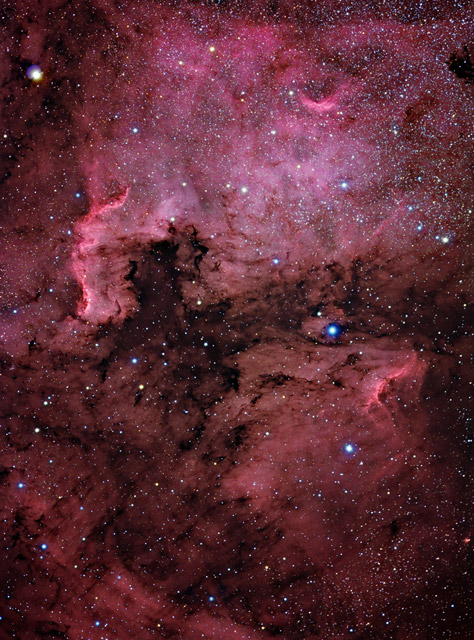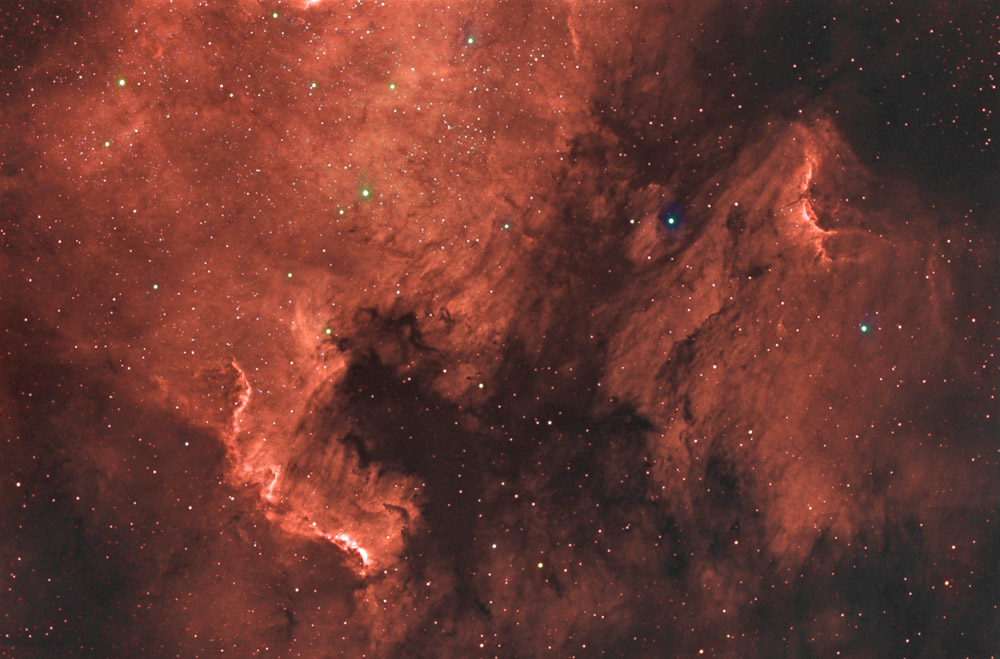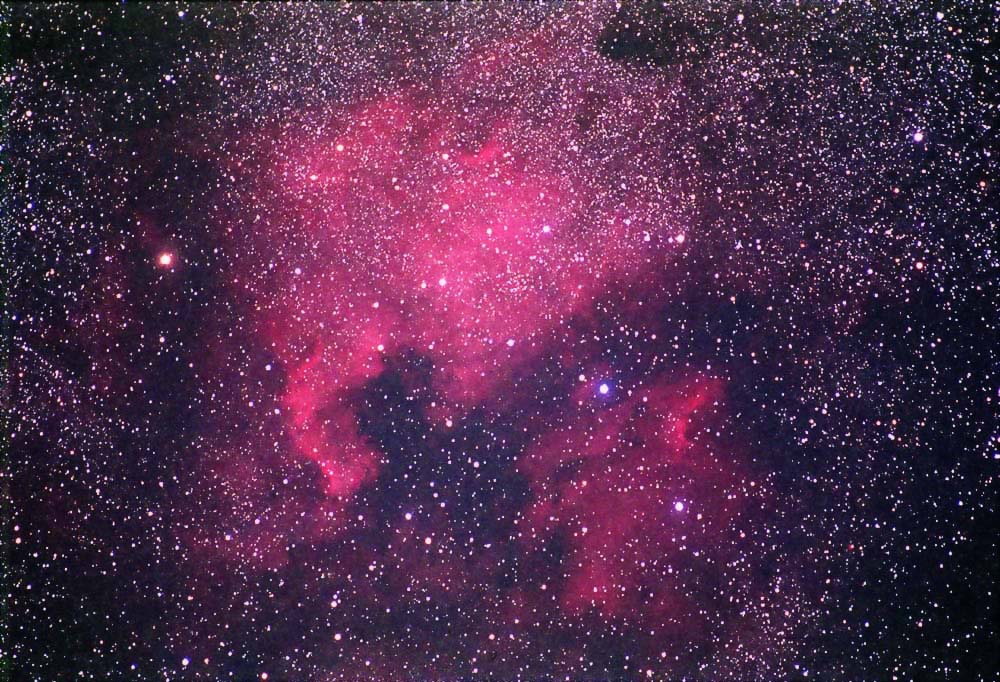| Time Travel Research Center © 2005 Cetin BAL - GSM:+90 05366063183 - Turkey / Denizli | |||||
|
|
|||||
|
NGC 7000
|
||||
|
CYGNUS - NEBULAE REGION - MAJESTIC! |
|||||

NGC 7000 and IC 5067/70 - NORTH AMERICA and PELICAN NEBULAE in CYGNUS
|
About this Object: |
|
A terrific region of the sky in the constellation Cygnus, this region of emission sources are among the skies most recognizsble objects. The shape of these two nebula remind most people, unmistakably, of the North America continent (top) and a Pelican (bottom). The pair rests just to west side of Deneb, the star at the top of the Swan or Northern Cross asterism. While not especially faint objects, these nebulae can be difficult to spot through telescopes because of their size. Binoculars and short focal length telescopes normally give you the better views...in dark skies, of course. If the skies are dark enough, don't be surprised if you can make out the North America Nebula with the naked eye. It's a sight to behold and a good indication as to the quality of your skies. |
Location:
Okie-Tex Star Party,
Kenton, OK
Date: September 18-19, 2006
Seeing:
3/10
Transparency: 9/10
Temperature: -25 degrees C on camera
Scope/Mount: Tak FSQ-106 @ f/5 on Paramount ME
Camera: SBIG STL-11000M astro CCD camera
Filter: Custom Scientific 4.5 nm H-alpha filter
Exposure Info: Ha+LRGB image; 150:60:30:40 minutes (10 minute
subexposures for LRGB, 30 minute subexposures for Ha)
Processing
Information:
Acquisition with CCDSoft.
Calibration (darks/flats), and registration in CCDstack (median combine).
RGB combine and Ha blending, color balance, levels/curves, and noise removal/local
contrast enhancement (Noel Carboni's Astronomy Tools) in Photoshop CS.
 |
Previous Images:
Click on the image for larger resolution (1600 x 1055 pixels)
North America and the Pelican - HaRGB image
This image of NGC 7000 and IC 5067/5070, the North America Nebula and the Pelican Nebula respectively, was acquired using two sets of data. One set is the color photograph shown immediately below and the other is the Hydrogen-alpha shot here. This technique uses the h-alpha information and blends it into the color information by becoming the "luminance" or detail layer in the image. The result perserves the color of the region while taking advantage of the details provided by the hydrogen-alpha data.
Click here to see this same object in Hydrogen-alpha light
Location: Texas
Star Party 2004 near Ft. Davis, Texas (RGB) and Eldorado Star Party 2004
near Eldorado, Texas (Luminance)
Date: May 17, 2004 (RGB) and October 15, 2004 (Luminance)
Scope/mount: Takahashi FSQ-106 @ f/5 and Tak NJP mount
Camera: SBIG STL-6303E, self-guided
Filter: Custom Scientific 4.5nm Hydrogen-alpha filter
Exposure Info: HaLRGB image - 120:30:30:30:10 minutes (10 min.
subexposures, all unbinned).
Processing Info: Dark frame calibration (no flats), de-blooming,
registration, and Sigma combine of all channels in MaxIm 4.0. Digital-Development
in Images Plus (RGB) and MaxIm 4 (Luminance). Blending of final data, Levels,
Curves, and color balance in Photoshop CS.
Processing Note: Original LRGB used as RGB for color information. Ha information blended 50% with Red layer in RGB set. Ha information used as luminance at 100%. Blue and Green information attenuated to allow for full luminance blend (for star halo reduction).

Click on the image to view at larger resolution (1600 x
1063)
North America and the Pelican in Cygnus
NGC 7000 and IC 5067/5070 comprise the North America Nebula and the Pelican
Nebula. These objects lie just next to Deneb in the Northern Milky Way
region of Cygnus. The North America Nebula is rather large, approximating
the width of 4 full moons. I managed to see hints of the dark lane between
these objects with my naked eye under the dark, remote night skies. A
gorgeous and easily photographed area of the sky.
Location: Texas
Star Party 2004 near Ft. Davis, Texas
Date: May 17, 2004
Temperature: 60 degrees F
Seeing: 8/10 (1.2 FWHM)
Transparency: 9/10
Scope/mount: Takahashi FSQ-106 @ f/5 and Tak NJP mount
Camera: SBIG STL-6303E, self-guided
Exposure Info: LRGB image - 30:30:30:10 minutes (10 min.
subexposures, all unbinned).
Processing Info: Dark frame calibration (no flats), de-blooming,
registration, and Sigma combine of all channels in MaxIm 4.0. Digital-Development
in Images Plus. Blending of final data, Levels, Curves, and color balance
in Photoshop CS.
Awards/Publications: This image won the BEST DEEP SKY PHOTOGRAPH at the 2004 Texas Star Party.

Location:
Texas Star Party 2003 near Fort Davis, Texas
Seeing:
7/10
Transparency:
9/10
Date and Time:
May 2, 2003 @ 2:40 AM CST and 2:51 AM CST
Equipment:
420mm @ f4 (300mm Nikkor ED lens with TC14B teleconverter) guided with Meade
208xt
Length:
A 10 minute exposure and 15 minute exposure stacked and averaged
Film:
Kodak Royal Gold 400
Processing Information:
Exposures were registered and averaged. Then slightly cropped with a levels
adjustment and contrast increase. Slight unsharp mask and gaussian blur
applied.
Exposure Notes: I think I finally got this object about right. Shows the excellent sharpness across the entire field of the Nikon lens with teleconverter when used wide open.
Astronomi Nebula Resimler Astrophotography Galaxy Resimler Yıldız Resimler
Copyright(c) 2003 - 2006 - Cetinbal - All rights reserved.